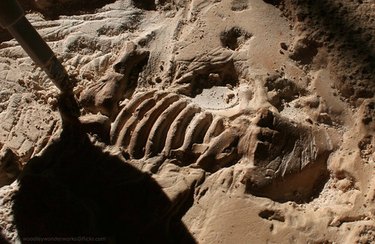
The process of fossilization replaces organic matter with minerals. These minerals seep into the object, harden and become fossil stone, a copy of that object that has the chemical properties of a rock.
Burial
Video of the Day
Animals that live in or near water have the best chance of becoming fossils. They sink to the sea bed and the remains are covered with sediment, protecting them from predation. Other animals may have been buried by sandstorms or even volcanic eruptions.
Video of the Day
Ancient Seas
Many of the richest deposits of fossil stones are in areas of the world that were once under water, such as the badlands of Alberta, Canada and North Dakota in the United States. Dinosaur National Park in Alberta is a perfect example.
Dinosaurs
Dinosaur bones are some of the most well known and extensively studied fossil stones and rarely contain any organic tissue. Exceptions, as reported in a BBC article about a T. Rex find, are met with excitement and in some cases skepticism.
Petrified Forest Stone
The logs in the Petrified National Forest in Arizona are actually fossilized stone. Over time the tree's tissues were replaced by silica deposits that crystallized into varieties of quartz including smoky and purple amethyst.
Fossil Stone as Fashion
Fossilized sea floor is another type of fossil stone. It is made up of a limestone base imbedded with fossil shells. This type of fossil stone is popular with jewelry makers since it is easy to cut and polishes well.